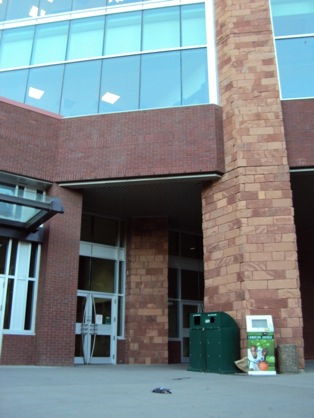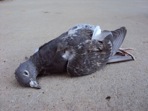What Can I Do to Reduce Mortality
from Window Collisions?
There hasn’t been that much scientific investigation into what keeps birds from being killed by window strikes.
Here is what we know about window collisions:
There is a lot of information about how windows kill birds
-Deaths due to window strikes are nonselective (Klem 1979, 2004; Drewitt and Langston 2008). In other words strikes can kill birds:
- of all species
- of both sexes
- of any age
- of any size
- of any condition (weak or strong)
- of any conservation status (abundant or endangered)
- from any where (resident birds or migrants)
-Windows angled 20-40° downwards reflect the ground rather than the sky or vegetation and substantially reduce window strikes (Klem et al. 2004).
-Placing bird attractants within 1 metre of windows decreases fatal strikes because birds won’t collide at high speeds (Klem et al. 2004)
Why birds get hit…
-Panic flights cause many window strikes. Birds can panic due to
- Pursuit by raptors
- Cars
- Large bird species arriving at feeders
- Loud noises
- Being chased by other birds of the same species
(Dunn 1993)
-Birds strike both clear and reflective windows (Klem 1979)
-Birds can’t tell that clear windows are barriers
-Reflective windows create the illusion of vegetation and sky
When strikes happen...
- Strikes occur in all seasons and under all weather conditions (Klem 1979).
- The most strikes occur in the winter and during spring and fall migration (Dunn 1993).
Here is what we are unsure of and are trying to understand better by this study:
-We have little data from homes that don’t have window strikes. Without this data we cannot be sure what factors actually affect strikes (Dunn 1993).
-Whether birds that are more active close to ground-level are at higher risk (Klem 1979)
- Thrushes, wood warblers, finches, etc
-How the distance of bird attractants from windows affects different bird species (Dunn 1993).
-Whether decals or hawk silhouettes actually reduce bird strikes (Klem 1990; Avery 1979)
-Whether placing plastic garden netting around windows decreases fatalities (Dunn 1993)
-Does light inside buildings cause nocturnal migrants to strike windows in residential areas as it seems to in commercial buildings? (Ogden 1996)
-If tinted glass or UV light patterns actually decreases strikes (Klem et al. 2004)




